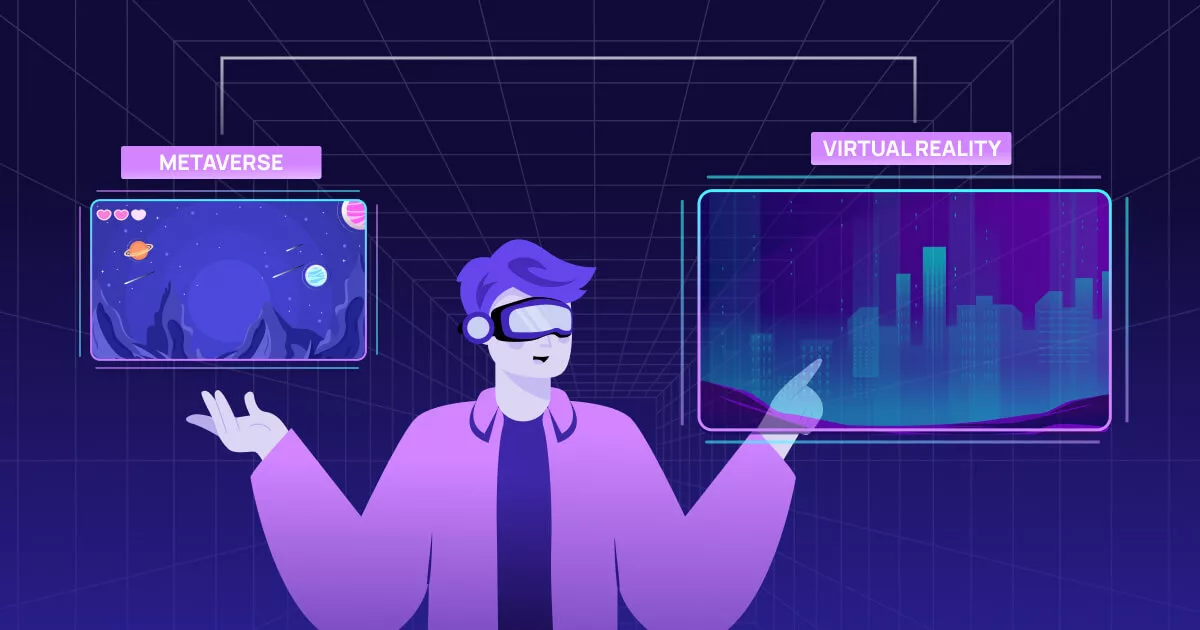
Science fiction has enticed us with the idea of virtual worlds where we can be whomever we want. The concept of a digital domain where you can lose yourself in a new world has caught everyone’s attention. This world is technically called the ‘Metaverse.’
Lately, there have been numerous developments in the metaverse space. The buzz surrounding it is growing louder by the day. With virtual reality (VR) technology and the metaverse becoming more intertwined, the comparisons between the two are the talk of the town.
If you’re new to this domain, you might have used these terms interchangeably. But the truth is that the metaverse and VR aren’t the same. In fact, there are many differences between these two technologies.
This article will help you discover the key differences, giving you a comprehensive understanding of both.
Get ready to explore the exciting world of the metaverse and virtual reality!
What Is Metaverse?
The metaverse refers to a virtual universe that serves as a shared space for people to interact with each other and with virtual environments. It is often imagined as a computer-generated environment where people can engage in gaming, socializing, and commerce. People in the metaverse exist as 3D avatars — digital representations of themselves.
The concept of the metaverse dates back to 1992.
Science fiction author named ‘Neal Stephenson’ introduced it in his novel “Snow Crash.” Stephenson envisioned the metaverse as a digital world where people could escape reality and immerse themselves in a new environment. In his book, the protagonist takes on a new digital identity, utterly different from his real life, as he explores the metaverse.
Today, the definitions of the metaverse often reflect the vision set forth by Stephenson.
While VR technology can provide an immersive and interactive experience in the metaverse, it is not the only way to access it.
Other technologies, such as desktop computers, mobile devices, and augmented reality (AR) devices, can also be used to access the metaverse. The metaverse is designed to be a seamless and interconnected virtual world. Thus it can be accessed using various devices and technologies, not just VR.
Anything a user creates or acquires within the metaverse, such as virtual property or items, belongs solely to them. The metaverse offers full ownership privileges to its users.
Also, the users can trade their assets, creating an entire economic system within the metaverse. The economy of the metaverse can include the following basic components.
1. Virtual currencies
Virtual currencies, such as Bitcoin (BTC) and Ethereum (ETH), can purchase virtual goods and services within the metaverse.
2. Virtual real estate
Virtual real estate refers to the ownership and use of virtual land or property within the metaverse, which can be bought, sold, and developed.
3. Virtual jobs
Virtual jobs refer to work opportunities within the metaverse, such as creating and selling virtual goods, providing virtual services, and gaming.
The metaverse can also incorporate real-world financial assets, such as stocks, bonds, and commodities, into the virtual environment.
This will lead to new investment opportunities within the metaverse. But, it also poses the following challenges —
- Risk of fraud and hacking
- The lack of regulation and security
- Challenges of integrating the virtual economy with the real-world economy
Major companies, including Facebook, Microsoft, Google, and Sony, have entered the metaverse space building their very own virtual world. The notion of the metaverse gained popularity following Facebook’s rebranding to Meta in October 2021.
The metaverse is still in its early stages of development. But, the proponents of the concept see it as a significant step forward in the evolution of the internet and human-computer interaction.
But, there are also concerns about the potential consequences. It includes the following.
- Privacy Concerns
- Addiction to virtual environments
- The need to establish regulations to govern behavior in the metaverse
What Is Virtual Reality (VR)?
Virtual Reality (VR) is a technology that creates a simulated environment that can be interacted with in a seemingly natural way.
With VR, users wear a headset that tracks their movements and displays a 3D world or environment around them. This technology aims to immerse the user in a digital world, giving them the feeling of being physically present within the virtual environment.
VR can be used for various applications, including gaming, education, simulation, and entertainment.
For example, in gaming, VR allows players to interact with digital worlds in a more immersive way. They use their bodies to control their avatars and engage in various activities.
In education, VR can provide students with realistic simulations and experiences that they would not be able to access in the physical world.
VR technology has indeed been around for decades. But computer graphics and hardware advancements have made it more accessible and affordable for consumers.
When using a VR system, the content you interact with is owned and managed by the brand, while you only possess the physical hardware. Essentially, you are participating in an experience that the brand controls. This kind of setup completely negates the possibility of building an economic system within the virtual environment.
The VR industry is expected to grow rapidly in the coming years, with many companies and organizations exploring new uses for VR technology.
Metaverse Vs. Virtual Reality: Key Differences
Below are the key differences between the Metaverse and Virtual Reality.
| CRITERIA | METAVERSE | VIRTUAL REALITY |
| Ownership | Metaverse grants ownership rights to users over their virtual assets and experiences. Anything users create or acquire in the metaverse, including virtual property or items, belongs to them. The metaverse provides users with full ownership privileges. | The VR content is owned and controlled by the brand, while the hardware equipment is the only aspect of the technology in your possession. You are essentially engaging with a brand-owned experience when utilizing a VR system. |
| Technologies | The metaverse is not solely dependent on virtual reality technology. It is driven by a multitude of other technologies. It includes AR, blockchain, and connectivity technologies. Furthermore, the metaverse is a large virtual world that accommodates integrating new technologies to offer advanced features. | VR technology is confined in its capabilities and can only simulate 3D environments. |
| Experiences | You can experience the virtual world just like you are moving around in the real world as a digital avatar | VR is experienced by wearing a headset or a gadget. |
| Persistence | Metaverse is a shared and persistent world that continues to exist even when you are absent. | The experience for the user stops when they switch off the VR device. |
Conclusion
The outcome of the metaverse vs. virtual reality debate highlights that the metaverse is much more than just VR.
While VR serves as a foundational technology for building the metaverse, it is limited in its capabilities. It can only allow users to access the environment.
Alternatively, the metaverse is a constantly growing virtual world encompassing a three-dimensional representation of the internet. The potential for innovation in the metaverse is limitless as it allows users to interact, engage, and trade with others within the environment.
FAQs
1. Can you access the Metaverse without VR?
Yes, it is possible to access the metaverse without VR.
While VR technology can provide an immersive and interactive experience in the metaverse, it is not the only way to access it.
Other technologies, such as desktop computers, mobile devices, and augmented reality (AR) devices, can also interact with the metaverse.
2. Do you need glasses for the metaverse?
It depends on the type of metaverse and the technology used to access it.
In some cases, glasses or a headset might be required to provide a fully immersive experience. In other cases, a desktop computer or mobile device might be enough.
For instance, the Facebook metaverse can be accessed using VR headsets such as the Oculus Quest or the HTC Vive. These VR headsets use displays and sensors to track the user’s head movements and provide a 3D experience.
In contrast, glasses might not be necessary if a metaverse is accessed using a desktop computer or mobile device.
3. Will the Metaverse replace the internet in the near future?
It is unlikely that the metaverse will completely replace the internet in the near future.
The metaverse is still in its infancy. While it has the potential to change the way we interact with the digital world, it is likely to complement the internet rather than replace it.
The internet is a global network of interconnected computers and devices providing access to information. But the metaverse is a virtual universe. It allows users to interact with each other and digital objects in a more immersive and interactive way.
In summary, the metaverse and the internet will likely coexist, each serving different purposes and user needs.





